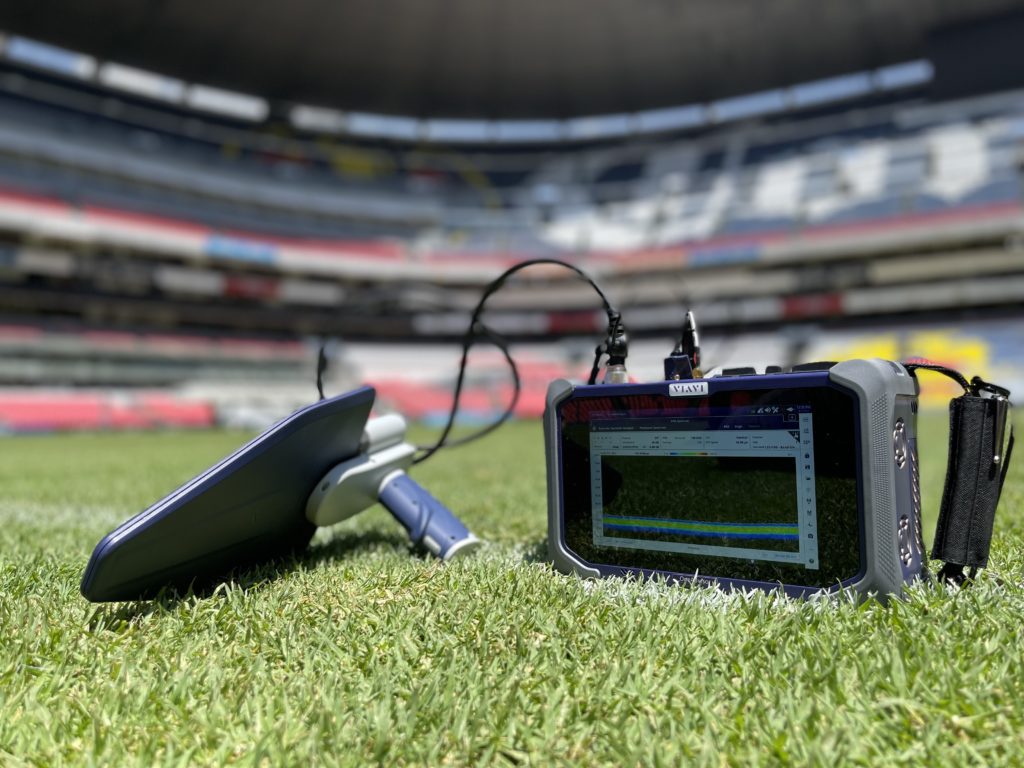The mobile experience in and around major stadiums is crucial to keeping customers happy as they browse, text, call and share their pictures and video from large sporting events or concerts. With tens of thousands of subscribers concentrated in a small area at very specific days and times, stadium usage is some of the most intensive that a mobile network needs to handle.
One lesser-known aspect of serving a stadium is that in addition to a mobile network operator’s public network for consumers, it may also be supporting private networks for stadium operations or team communications on the field. In some cases, this private network support needs to be extended to overseas venues visited by the team. The National Football League, for example, has an International Series of games where U.S. teams face off against one another in international stadiums. That represents a major challenge for communications continuity, because the MNOs are no longer on their “home turf” where they have a deep understanding of which wireless bands they can use to operate, as well as the status of neighboring spectrum bands, licensed or unlicensed, that might represent sources of interference. They likely have existing roaming agreements with local operators to handle their mobile consumers, but if they are operating a private network for a team, the MNOs have to test and verify how to take that communications capability abroad for use at an international marquee event.
VIAVI Solutions has been supporting stadium radio frequency testing both domestically and for venues overseas. Eduardo Inzunza, business development manager for VIAVI Solutions, explains that the top priority for service providers who are operating a private network abroad is to get a strategic overview of the RF environment: Which local frequency bands are in use? Which spectrum is available? Which channels offer the best RF conditions? He said that MNOs are typically looking to use the midband airwaves from 3.4-3.8 GHz—a range that is shared (CBRS) or licensed (3.45 GHz, C-Band) in the U.S., but which may be licensed or unlicensed in other countries, with satellite operations or private networks actively transmitting. For team communications, operators are usually trying to locate a usable swath of several 20-megahertz channels to operate a private LTE network, he added.

“They have a need to go and test how ‘clean’ the spectrum is, and to understand what frequencies and bands are available, because the allocation of spectrum is different internationally,” Inzunza said. This knowledge is particularly crucial for operators because they don’t have information and insights from their local macro or in-stadium network on which to rely. There could be rogue signal boosters nearby, or RF noise from electronic billboards, video cameras or other devices that impact the in-stadium environment; or the spectrum could simply be in use by incumbents such as satellite or government operations because of differences in international spectrum allocations.
Strategically, that means operators must undertake venue-specific RF testing across multiple countries and continents to work out an informed, pre-game-day deployment strategy. Inzunza said that in the international stadium testing which VIAVI has supported, the players and coaches’ private communications networks have been the priority for pre-deployment RF testing of the spectrum environment. The focus was primarily on identifying potential sources of interference and spectrum clearing.
In one specific case of a stadium abroad, testers used VIAVI Solutions’ the OneAdvisor 800 handheld field instrument from VIAVI to assess spectrum usage and potential interference sources at 3.4-3.8 GHz. Six fixed locations were chosen for testing that spanned the length and width of the playing field. Four tests were conducted at each location, in 100-megahertz swaths (3.4-3.5 GHz, 3.5-3.6 GHz and so on) to search for RF energy and obtain evidence of how clear the spectrum was—or wasn’t. The OneAdvisor 800 supports real-time and persistent spectrum analysis, which enables mobile operators to get a snapshot of the presence or absence of RF energy that could cause issues, with a granular view down to RF events as brief as a few microseconds. The instrument has several features that make RF interference identification and spectrum clearing easier, including TDD Automatic Gated Sweep (important for identifying TDD interference due to timing issues) and a “Blind Scanner” ability that allows an engineer to step into an unknown RF environment and quickly identify the active channels in use, whether LTE, DSS, or 5G. This drastically cuts time at the site.
At the international stadium being tested, the OneAdvisor 800 revealed that RF conditions varied considerably across frequency bands, even though all six test locations were on the field itself – a relatively contained area. The first test location, on one side of the field about halfway between midfield and the end zone, was mostly quiet across the entire spectrum tested. But the second location – just a few meters away at midfield – showed significant RF energy at 3.4-3.5 GHz. There was also a big difference between how clear 3.4-3.5 GHz was at the midfield on one side of the field versus the other: On one side, the band didn’t show any interfering signals, but on the other side, there was persistent interference that also extended to some of the other six test sites.
The broad and deep RF visibility of the OneAdvisor 800 helped the operator to understand the state of local spectrum and what airwaves they might use to enable the fastest possible deployment of a private network, Inzunza explains. Ultimately, in this case, the operator was able to use the testing data to decide that 3.5-3.6 GHz was the best choice for operation of the team’s communications network during their visit abroad.
For more information about the OneAdvisor 800 and its use for spectrum analysis and clearing, check out www.viavisolutions.com/5G-field

